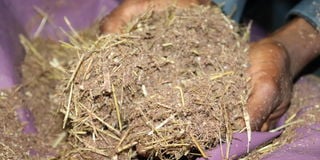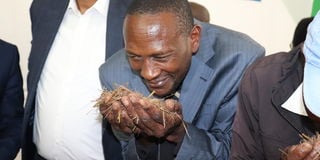New fermented livestock feed promises higher milk yields and lower costs for Nakuru farmers

A close-up of the Total Mixed Fermentation (TMF) feed, which was launched on August 1, 2025 at the Kenya Agricultural and Livestock Research Organisation (KALRO) Beef Research Institute in Lanet.
A new livestock feed made from fermented crop waste has been launched, promising to reduce feed costs and boost milk production for small scale farmers struggling with rising input prices and changing weather patterns.
Known as Total Mixed Fermentation (TMF), the feed was unveiled on August 1, 2025 at the Kenya Agricultural and Livestock Research Organisation (KALRO) Beef Research Institute in Lanet.
It was developed through a collaboration between KALRO and Farm Feed Biotech.
This technology, which was adapted from South Korea, uses locally sourced agricultural waste, such as rejected tomatoes and avocado residues, to produce climate-smart livestock feed.
Microbial fermentation enhances the digestibility, nutritional value, and shelf life of the feed without the need for preservatives.

Alex Karanja, a farmer and the chairman of the Nakuru Fresh Dairy Cooperative, smells the new feed at its launch on August 1, 2025 at the Kenya Agricultural and Livestock Research Organisation (KALRO) Beef Research Institute in Lanet.
Alex Karanja, a farmer from Lanet, believes that the new feed formulation could alleviate many of the challenges faced by the livestock sector.
“We deal with high feed prices due to the soaring cost of key components such as maize, sunflower and soy, unreliable rainfall and pastures that don’t meet nutritional needs,” says Karanja, who also chairs the Nakuru Fresh Dairy Cooperative.
Poorly balanced feed rations from small and medium enterprises trying to enter the market have been the biggest headache.
Having taken part in the pilot scheme, Karanja's three cows, which previously produced an average of 20 litres per cow per day — a feat he attributes to his disciplined farm management — have increased their production to 30 litres per cow in just one month of using TMF.

From left: Silver Lee (CEO of Farmfeed Bio), Dr Tura Isako (Director of the KALRO Beef Research Institute) and Leonard Bor (Nakuru County Executive Committee Member for Agriculture) on August 1, 2025 during the launch of the new Total Mixed Fermentation (TMF) feed at the KALRO Beef Research Institute in Lanet.
“I thought we were already doing well, but this feed has increased our productivity without the need for additional supplements,” he says.
Nakuru produced just over 440 million litres of milk in 2024 from approximately 456,000 dairy cows. Yet, despite this output, feed remains a persistent challenge for both dairy and beef producers.
According to Leonard Bor, the CECM Agriculture Nakuru, the region has an abundance of crop residues and food by-products that are currently underutilised.
He cites cabbages that often go to waste during surpluses and avocados that fail to meet buyers’ standards due to minor damage or over-ripeness as examples of potential ingredients for the new feed formulation.
“Despite being a food basket, Nakuru generates a lot of vegetable waste that could be used for feed production,” says Bor, adding that urban development poses a significant risk to grazing areas and that there is an increasing need to develop structured feedlot systems to ensure that animals can be fattened efficiently.
While the county has made strides in the dairy sector, the beef industry remains largely untapped despite its strong local and regional market potential.

Dr Tura Isako, Director of the KALRO Beef Research Institute, launched the new Total Mixed Fermentation (TMF) feed at the Institute in Lanet on August 1, 2025.
Dr Tura Isako, KALRO Director, says the technology aims to improve feed security by providing a cost-effective, environmentally sustainable option.
However, not all farmers have been able to access the new formulation.
Samuel Maina Wachira, a dairy farmer in Lanet Umoja who is not part of the pilot scheme, says he hopes the feed will be made more widely available.
"We’re still using dairy meal and grass, but it’s not enough. The cost is high and the quality varies. If TMF can deliver more milk at a lower cost, farmers like me would benefit, but we’d need to know how to process or access it,” he says.


